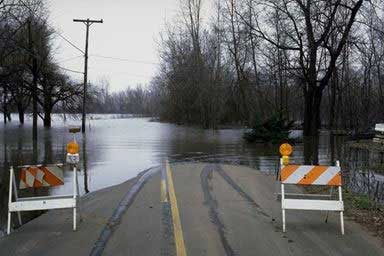|
|
 |
|
|
|
 |
| |
|
|
 |
How are
people changing
the climate?
Basics |
2. What will
a warmer world be like?
How the climate affects people:
Example 1
Europe is flooding!
|
|
|
|
|
 |
|
July 2002: Soldiers, police, firefighters and volunteers hoist sandbags to build dams in Prague (the capital of the Czech Republic), and the German city Dresden. The water is rising dangerously in the Vltava river in Czechoslovakia and downstream in Germany’s Elbe after heavy rains. The Danube and several tributaries are also swelling over their banks. Hundreds of thousands of people must be evacuated from their homes before they are flooded.
|
Meanwhile the debate rages in newspapers, TV and radio: Is this a sign of man-made climate change? No one can know for sure if this particular event can be ascribed to human emissions of CO2 and other greenhouse gases because we have always had floods and extreme weather. But when the world becomes warmer, warn experts, some extreme weather events like this will become more commonplace.
|
 |
 |
 |
|
1. FLOODING: Streets turn into rivers. Photo: Corel Gallery
|
|
|
Packing up
The rescue team care little about the causes of the flood; they are more concerned about coping with it. In some places the water is rising by one meter per hour, so they have to hurry! Trucks with sand bags are driven into the cities. Sheets of iron several meters high are also being used to hold the water back. Water pumps are being set up to pump the water back into the river. In the museums, the basements are being emptied of valuable artwork before they are flooded. Military helicopters transport patients to safer hospitals.
In both large and small cities along the rivers, people are packing their bags and cars and trying to secure their homes as well as they can before they escape from the rising water. Some go to relatives and friends. Others are gathered in large tent camps to wait for the water levels to drop again. In one village, people are clinging to their rooftops. They waited too long to evacuate. Some are trying to save themselves using a raft, but the raft capsizes.
Meanwhile, the rescue team has a difficult job where the flooding is worst. Radio and TV signals as well as electricity are lost throughout large areas; roads and bridges are washed away by the water, and boats must be used instead for transportation. In some places, it is dangerous to cross the river even in a boat.
|
 |
 |
|
2. FLOODING: Satellite image of the Elbe August 2000 and August 2002 (after flooding). Photo: NASA (click to enlarge, 195 kB)
|
|
 |
The authorities recommend that people save food and water, since many stores must remain closed. Boats and barges that had come loose from their moorings must be blown up so they do not destroy bridges further downstream.
Europe’s major rivers have always overflowed from time to time. But the water levels of the Vltava and Elbe rivers reached record heights in 2002. In some places, the water level increased by over ten meters. Flood-related accidents killed twelve people in Germany and nine in Czechoslovakia. The material damages were in the order of billions of euro. |
|
Underinsured
The impacts of such an event can be felt for a long time. It takes time before people can move back to their homes, and even though the river has returned to normal levels, there is still water in the walls, floors, and ground. People cannot move back into the buildings until they can be sure that the electricity and walls in the ground floor are undamaged. Farmers living along the river complain that the water has washed away soil and crops. And as the water dries up, another problem presents itself: Many flood victims did not carry insurance, and thus cannot afford to repair their homes and businesses. This was the case for many in eastern Germany, and the German government promised federal aid to help those in need.
Scenes like this – the flood of summer 2002 – can become more common in the future. With continued global warming we can expect more intense and more frequent floods in large rivers such as the Vltava, Elbe, Rhine, and Danube and their tributaries because of the increased rainfall that is expected over large parts of Europe (although in the far south it can become even drier). Continual flooding can cause damage in the order of billions of euro. To adapt, it may be necessary to move residential and business areas, change agricultural practices, and build new canals, dams, and drainage systems. In addition, irreplaceable cultural heritage in the form of historical buildings are at risk when the water rages through the city streets. If you look at a map of Europe, you can see that many of Europe’s capitals and major cities lie alongside large rivers.
|
|
Author: Camilla Schreiner - CICERO (Center for International Climate and Environmental Research - Oslo) - Norway. Scientific reviewers: Andreas Tjernshaugen - CICERO (Center for International Climate and Environmental Research - Oslo) - Norway - 2004-01-20 and Knut Alfsen - Statistics Norway - Norway - 2003-09-12. Educational reviewer: Nina Arnesen - Marienlyst school in Oslo - Norway - 2004-03-10. Last update: 2004-03-27. |
|
 |
|









